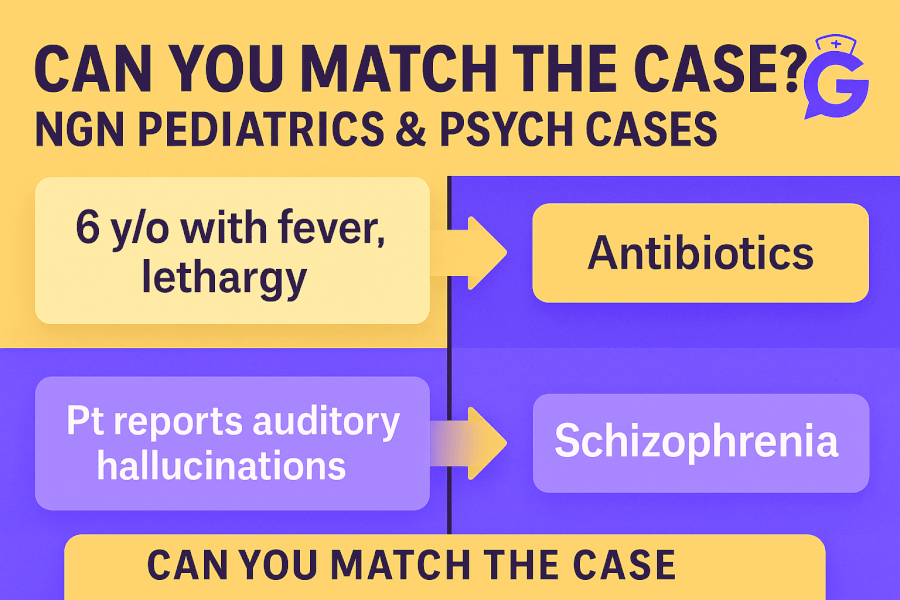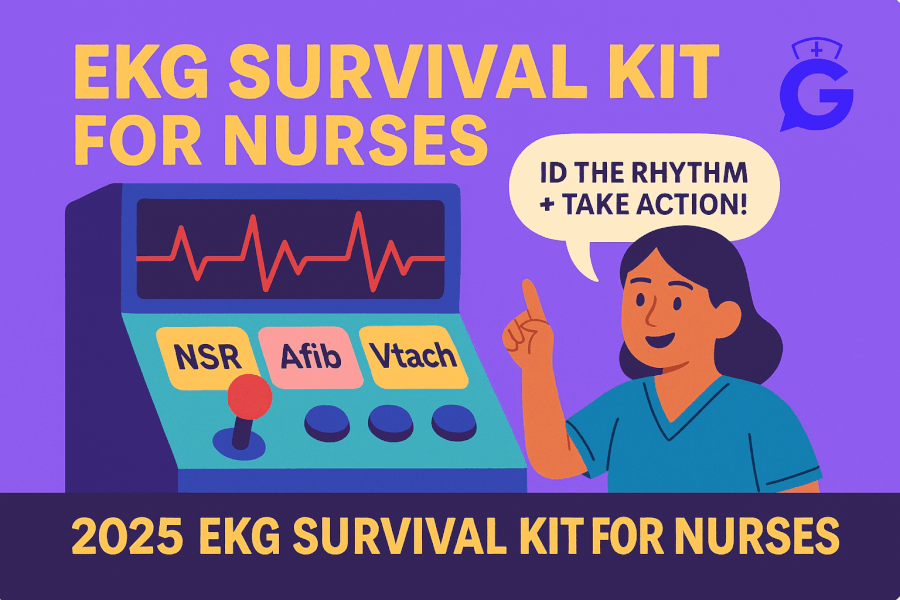Pediatrics and mental health items reward calm, safety-first decision-making. Your job is to spot red-flag cues, name a single priority, take two safe, effective actions, and pick two parameters that prove your intervention worked within 10–30 minutes. If your stem-reading feels rusty, warm up with How to Read NGN Case Stems (2025): Clinical Judgment Strategy Guide, then reinforce format skills with NGN Bow-Tie Items (2025) and NGN Matrix/Grid Items (2025).
Table of Contents
- How to Use These Case Studies
- Case 1: Croup vs. Epiglottitis—Airway First
- Case 2: Pediatric Asthma Exacerbation
- Case 3: Gastroenteritis—Dehydration & Rehydration
- Case 4: Febrile Infant—Sepsis Screen
- Case 5: Bronchiolitis (RSV)—Moderate Distress
- Case 6: Adolescent Type 1 DM—Sick-Day Ketosis
- Case 7: Suicidal Ideation—Safety & Level of Observation
- Case 8: Serotonin Syndrome vs. Neuroleptic Malignant Syndrome
- Case 9: Command Hallucinations—Milieu Safety
- Case 10: Alcohol Withdrawal—Preventing Delirium Tremens
- FAQs
- Further Reading
🎯 Free NCLEX quiz!
Test your knowledge—new quizzes added weekly!
How to Use These Case Studies
- Read once for timeline and trend words (sudden, worsening, after medication).
- State the priority aloud; choose two actions and two parameters you’ll reassess in 10–30 minutes.
- For instability patterns that cross into med-surg, practice with NGN Med-Surg / Physiological Adaptation Case Studies (2025).
- When meds drive the case, review NGN Pharmacology Case Studies (2025).
Case 1: Croup vs. Epiglottitis—Airway First
Stem: Toddler with barking cough, inspiratory stridor, mild retractions, afebrile; tolerating secretions. Another toddler presents drooling, muffled voice, tripod position, high fever.
Priority problem: Distinguish croup (upper airway inflammation) from possible epiglottitis (airway emergency).
Two best actions:
- Stable croup: Humidified air, steroid/nebulized epi per order; keep calm.
- Suspected epiglottitis: Do not examine throat; keep child upright, provide blow-by O₂, call anesthesia/ENT for controlled airway.
Two parameters: Work of breathing/stridor; SpO₂ and mental status.
Rationale: Croup is often supportive care; epiglottitis demands immediate airway control.
Faculty tip: If you’re tempted to “peek” at the throat, stop. Disturbing the airway can precipitate obstruction.
Case 2: Pediatric Asthma Exacerbation
Stem: School-age child with wheeze, prolonged expiration, RR 34, SpO₂ 91% RA, speaks in phrases, mild intercostal retractions.
Priority problem: Bronchospasm with ventilation/oxygenation compromise.
Two best actions:
- Short-acting beta-agonist via spacer/nebulizer per order; supplemental O₂ to target sats.
- Systemic steroid per order; reassess response after bronchodilator.
Two parameters: SpO₂ and RR; air entry/wheeze intensity.
Rationale: Open airways fast, reduce inflammation, and verify improved gas exchange.
Case 3: Gastroenteritis—Dehydration & Rehydration
Stem: Toddler with vomiting/diarrhea; dry mucosa, cap refill 3–4 s, tachycardic, ↓ urine output.
Priority problem: Moderate dehydration with risk for hypovolemia.
Two best actions:
- Begin oral rehydration therapy (small frequent sips) if able; if unable/severe, IV isotonic fluids per order.
- Strict I&O; parent education on return precautions.
Two parameters: Urine output; capillary refill/HR.
Rationale: Restore circulating volume and monitor response.
Case 4: Febrile Infant—Sepsis Screen
Stem: 6-week-old with temp 38.6°C, poor feeding, irritability; no obvious source on exam.
Priority problem: Possible neonatal sepsis.
Two best actions:
- Sepsis workup per protocol (cultures, labs) and empiric antibiotics as ordered.
- Maintain thermoregulation and monitor perfusion.
Two parameters: Temp trend; perfusion signs (cap refill, HR), alertness/feeding.
Rationale: Neonates can decompensate quickly; early antibiotics are time-critical.
Case 5: Bronchiolitis (RSV)—Moderate Distress
Stem: Infant with tachypnea (RR 64), nasal flaring, intercostal retractions; poor feeding; SpO₂ 90–92% RA.
Priority problem: Impaired gas exchange with dehydration risk.
Two best actions:
- Nasal suctioning and supplemental O₂ to maintain target sats; small frequent feeds or IV fluids if needed.
- Minimal stimulation and positioning for comfort.
Two parameters: Work of breathing/SpO₂; intake/output and weight.
Rationale: Clear secretions, support oxygenation, and keep calories/hydration adequate.
Case 6: Adolescent Type 1 DM—Sick-Day Ketosis
Stem: Viral illness; glucose 310 mg/dL; moderate ketones; mild abdominal pain; dry mucosa.
Priority problem: Ketosis with dehydration risk.
Two best actions:
- Hydration and supplemental insulin per sick-day plan/provider order.
- Teach sick-day rules (never stop basal insulin; check ketones; when to seek care).
Two parameters: Glucose/ketone trends; intake/output and mental status.
Rationale: Prevent progression to DKA while maintaining insulin supply.
Case 7: Suicidal Ideation—Safety & Level of Observation
Stem: 17-year-old shares a specific plan with access to means; depressed mood; recent breakup; substance use.
Priority problem: Imminent self-harm risk.
Two best actions:
- Implement 1:1 observation and remove lethal means; place in safe environment.
- Notify provider; initiate suicide precautions and safety planning with the client.
Two parameters: Level of observation maintained; change in ideation/intent.
Rationale: Control environment and monitor continuously while initiating treatment.
Faculty tip: Document the exact words used to describe plan/intent and your observation level. It matters clinically and legally.
Case 8: Serotonin Syndrome vs. Neuroleptic Malignant Syndrome
Stem: Adult on SSRI + new linezolid; now agitated, diaphoretic, tremor, hyperreflexia, temp 39.2°C. Another client on antipsychotic develops rigidity, bradykinesia, hyperthermia, altered mentation, ↑ CK.
Priority problem: Distinguish serotonin syndrome from NMS—both life-threatening.
Two best actions:
- Suspected serotonin syndrome: Stop serotonergic agents; supportive care; anticipate serotonin antagonists per order.
- Suspected NMS: Stop antipsychotic; cooling/fluids; anticipate dantrolene/bromocriptine per order; monitor for rhabdo.
Two parameters: Temp/rigidity/mental status; CK/renal function and vitals.
Rationale: Prompt drug cessation and supportive therapy reduce mortality.
Case 9: Command Hallucinations—Milieu Safety
Stem: Client with schizophrenia reports voices telling them to harm a roommate; pacing, guarded, poor sleep.
Priority problem: Risk of violence due to command hallucinations.
Two best actions:
- Increase observation level, ensure safe milieu; de-escalation with calm, reality-based statements.
- Administer PRN antipsychotic/anxiolytic per order; coordinate with team for environment adjustments.
Two parameters: Intensity/frequency of commands; behavior (agitation, pacing), sleep.
Rationale: Reduce risk, lower arousal, and target symptoms.
Case 10: Alcohol Withdrawal—Preventing Delirium Tremens
Stem: 48 hours post-last drink; tremor, agitation, BP 168/102, HR 118, diaphoresis, insomnia; CIWA trending up.
Priority problem: Severe withdrawal risk progressing to DTs.
Two best actions:
- Benzodiazepine protocol per CIWA; IV fluids and thiamine per order; reduce stimuli.
- Seizure precautions; continuous monitoring for vitals and mental status changes.
Two parameters: CIWA score; vitals (BP/HR/temp) and level of agitation.
Rationale: Symptom-triggered therapy lowers complications and mortality.
Faculty tip: If two actions seem reasonable, pick the one that changes physiology first (airway, perfusion, neuro) and that you can measure soon after.
FAQs
How many actions/parameters should I select on these screens?
Usually two and two unless the item specifies otherwise. Choose interventions that directly stabilize the priority.
Is “call the provider” ever first?
Yes—after you’ve done the safe nursing step you can implement immediately (e.g., oxygen, positioning, stop an offending medication).
How do I avoid over-selecting on matrices?
State the priority out loud; choose only cues/actions that support it. If it’s routine but not priority-driven, skip it.
What’s a quick daily practice routine?
10–20 minutes: 1–2 cases + brief rationale read. Layer in timed mixed sets weekly. For pacing ideas, see How Long Should I Study for the NCLEX?.







